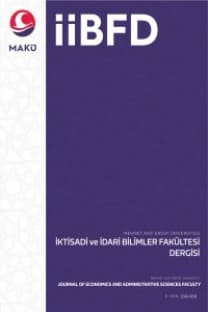BOYA SEKTÖRÜNDE TEDARİK YÖNETİMİ FAALİYETLERİNİN SÜREÇ YÖNETİMİ İLE İYİLEŞTİRİLMESİ
Süreç Yönetimi, Tedarik Zinciri, Boya Sektörü
IMPROVING PROCESS MANAGEMENT OF SUPPLY MANAGEMENT ACTIVITIES IN PAINTING SECTOR
Process Management, Supply Chain, Paint Industry,
___
- Arndt, H. (2008). Supply Chain Management. Gabler Verlag Springer Fachmedien Wiesbaden GmbH, Wiesbaden.
- Born, G.(1994). Process Management to Quality Improvement, Chichester : Joh Wiley & Sons.
- BOSAD (2015). Dünya’da ve Türkiye’de Boya Sektörü Raporu. İstanbul.
- Carmignani, G. (2009). "Supply chain and quality management: The definition of a standard to implement a process management system in a supply chain", Business Process Management Journal. 15(3): 395-407.
- Champy, J and Hammer, M. (2002) The Emergence of Business Process Management, A Report by Computer Sciences Corporation, Hampshire.
- Chandra C., Kumar S. (2001), ‘Taxonomy of Inventory Policies for Supply Chain Effectiveness”, 29(4):164-175
- Croxton, K. L., Garcia-Dastugue, S. J., Lambert, D. M., & Rogers, D. S. (2001). The supply chain management processes. The International Journal of Logistics Management, 12(2), 13-36
- Davenport, T.H. (1993). Process Innovation: Reengineering Work Trough Information Technology. Boston: Harvard Business School Press.
- Dumas, M., La Rosa, M., Mendling, J., Reijers, A. (2013). Fundamentals of Business Process Management. Berlin: Springer Berlin Heidelberg.
- Hammer, M., Champy, J. (1996). Değişim Mühendisliği. Çev. S. Gül. İstanbul: Sabah Kitapları
- Kirchmer, M. (2011). High Performance Through Process Excellence: From Strategy to Operations. Berlin: Springer Berlin Heidelberg
- Kobayashi, T., Tamaki, M., Komoda, N. (2003). Business process integration as a solution to the implementation of supply chain management systems. Information & Management, 40(8), 769-780.
- La Londe, B. J., Masters, J. M. (1994). Emerging logistics strategies: blueprints for the next century. International journal of physical distribution & logistics management, 24(7), 35-47.
- La Londe, Bernard J. and James M. Masters (1994), “Emerging Logistics Strategies: Blueprints
- McAdam, R., McCormack, D. (2001). Integrating business processes for global alignment and supply chain management. Business Process Management Journal, 7(2), 113-130.
- Mentzer, J. T., DeWitt, W., Keebler, J. S., Min, S., Nix, N. W., Smith, C. D., Zacharia, Z. G. (2001). Defining supply chain management. Journal of Business logistics, 22(2), 1-25.
- Özer, M. (2010). Kuruluşlarda Süreç, Performans ve Risk Analizi / Yönetimi. Ankara: Adalet Yayın Evi
- Pradabwong, J., Braziotis, C., Tannock, J., & Pawar, K. S. (2017). Business process management and supply chain collaboration: effects on performance and competitiveness. Supply Chain Management: An International Journal, 22(2).
- Trkman, P. (2009). The Critical Success Factors of Business Process Management. Ljubljana: International Journal of Information Management. 10(2): 125-134.
- Tunçgenç, M. (2015). Türk Boya Sanayisi. Kimya Mühendisleri Odası Yayınları.
- ISSN: 2149-1658
- Yayın Aralığı: 4
- Yayıncı: Mehmet Akif Ersoy
SOSYAL MEDYA ANALİTİĞİ İLE DEĞER YARATMA: DUYGU ANALİZİ İLE GELECEĞE YÖNELİM
Burcu AKIN, Umman Tuğba GÜRSOY ŞİMŞEK
ALT SINIR TEMELİNE DAYALI AĞIRLIKLI TAVLAMA YÖNTEMİ İLE KUTULAMA PROBLEMİNİN ÇÖZÜMÜ
Neriman İNAK, Sezai TOKAT, Kenan KARAGÜL
ÖRGÜTSEL İKLİMİN ÖRGÜTSEL BAĞLILIĞA ETKİSİ: ÖZEL HASTANE ÖRNEĞİ
Türker BAŞ, Mustafa AMARAT, Özgün ÜNAL, Ayhan DURMUŞ, Şeyma BOZ
Fatih CEYLAN, Osman TÜZÜN, Ramazan EKİNCİ, İşıl EREM CEYLAN
AKDENİZ’E KIYISI OLAN ÜLKELERDE KURUMSAL YAPININ TURİZME ETKİLERİNİN ANALİZİ
Seyfettin ARTAN, Pınar HAYALOĞLU, Selim Koray DEMİREL
BOYA SEKTÖRÜNDE TEDARİK YÖNETİMİ FAALİYETLERİNİN SÜREÇ YÖNETİMİ İLE İYİLEŞTİRİLMESİ
